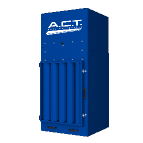
Food processing dust presents numerous challenges in food manufacturing, including health, safety, food processing regulations, and combustible dust risks. Common food processing dust may come from a wide range of ingredients, such as spices, flour, corn starch, sugar, eggshell dust, flavoring additives, feed, and raw grain agricultural products, and more. Applications can include bulk and material handling, conveying, and silo and bin venting.
A dust collector designed for food processing dust is essential for protecting the health of employees, safety of your facility and equipment, as well as food safety, which protects the health and well-being of consumers buying the products coming from your facility.
Why Food Processing Dust Removal is Important
Since food processing dust includes ingredients such as flour, sugar, and grain, the dust that is produced is often lightweight and fine, making it susceptible to remain in the air as well as other areas of your facility. There are several risks and challenges associated with food processing dust, such as employee health and safety, combustible dust, food safety and quality, and equipment maintenance.
Employee Health & Safety
Employee health can especially be impacted if food processing dust lingers in the air and is inhaled, which can lead to health issues. When an efficient dust collector for food processing is in place, employees are protected from potential health risks, as well as any slip risks with dust that has settled on surfaces where a worker may fall. There are additional safety risks to employees related to combustible or explosive dust, which can potentially cause even greater harm.
Combustible Dust
Since food processing dust can often be combustible, including sugar, spice, starch, flour, and more, the best dust collector will not only protect employee health, but the overall safety of your facility. Since food processing dust is often fine and lightweight, this means that it can linger in the air, making it susceptible to an explosion or fire. Explosions can also occur during food processing if dust combusts too quickly in an enclosed space.
OSHA offers guidance and standards to help keep your facility safe when it comes to combustible dust. Be sure to follow other regulations such as NFPA, USDA, and FDA.
Food Safety & Quality
Another risk of food processing dust is food safety and quality – effective dust removal can decrease the risk of sanitation issues, cross-contamination (including allergens), and more. Food processing dust may carry bacteria, pathogens, or other contaminants that put consumers at risk. Dust can also affect the quality or appearance of food, which can affect packaging and storage. With the right dust collector, the risk of contamination can be reduced significantly.
Equipment Maintenance
Food processing dust can also potentially cause damage to equipment, leaving employees with downtime while equipment is being repaired. It can also cause reduced efficiency and increase time required for maintenance. By using a dust collector, you will keep food processing dust out of equipment, allowing it to function better for longer, with less need for repairs.
How a Cartridge or Baghouse Dust Collector Can Help with Food Processing Dust Collection
-
Dust can occur at any stage of food processing, including mixing, pouring, or transferring. Because of this, it’s ideal to capture food dust particles early in the process. Depending on the type of material and application, a cartridge or baghouse dust collector can improve food processing dust collection. Learn more about some of the differences in our guide.
A few overall considerations as you determine the best dust collector for food processing:- Efficiency – How well does the dust collector capture the type of food processing dust at the source?
- Filtration – Will a cartridge filter or baghouse filter work better with the type and size of dust in your facility? The right dust collector should fit the needs of the type of dust; from fine to coarse.
- Combustible Dust Prevention – How well does the dust collector protect your facility against potential explosions and fires? Consider if the dust collector has explosion vents, flame suppression systems, and sprinkler connections.
- Cleaning and Maintenance – How easy is it to clean the dust collector?
- Safety Regulations – Does the dust collector follow safety guidelines for OSHA, NFPA, etc.?
When to Use a Cartridge Dust Collector
A cartridge dust collector typically works best for smaller facilities, as they offer compact designs, high filtration efficiency, and easy maintenance
When to Use a Baghouse Dust Collector
A baghouse dust collector is more ideal for a large food processing facility, as it can handle higher volumes of dust.
Find the Best Industrial Dust Collector for Food Processing
If you’re ready to improve the safety of your facility, equipment, and food, contact A.C.T. today to learn more about our dust collector systems.
Learn how A.C.T. helped one large manufacturer of snack foods to find a compliant dust collector.



























%20Collectors%20Image.png?width=143&height=143&name=ADC%20(Ambient)%20Collectors%20Image.png)




























.png?width=240&height=91&name=ACT%20Dust%20Collectors%20Logo%20Solid%20White%202020%20(1).png)
.png?width=148&height=149&name=usa-manufactured-dust-collectors%20(1).png)